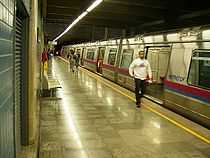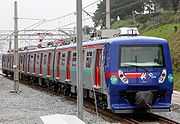Brasília Metro
| Brasília Metro | |||
|---|---|---|---|
 | |||
| Background | |||
| Locale |
Brasília, DF, | ||
| Transit type | Rapid transit | ||
| Number of lines | 2 | ||
| Number of stations | 24 (5 more planned)[1] | ||
| Website | Metrô - DF | ||
| Operation | |||
| Began operation | 2001[2] | ||
| Operator(s) | Companhia do Metropolitano do Distrito Federal | ||
| Technical | |||
| System length | 42.4 km (26.3 mi)[1] | ||
| |||
Brasília Metro (Portuguese: Metrô de Brasília, commonly called Metrô) is the metro system in Brasília, the capital of Brazil. It is operated by Metro-DF or Companhia do Metropolitano do Distrito Federal, and was opened in 2001.[2] Currently, Brasília's Metro has 24 stations[1] on two lines, and runs for 42.38 kilometres (26.33 mi).[1] The Metro operates from 06:00 AM to 11:30 PM Mondays to Saturdays, and from 07:00 AM to 7:00 PM on Sundays. It covers part of the metropolitan area. Its main problem is the sheer distance between stations, making it a small component of the transit system of Brasília. The community of Águas Claras is well served by the system, making it one of the fastest-growing areas of Brasília.
The access to Metro-DF is controlled by electronic entry and exit barriers. To travel on the metro, tickets are unitary, which contains a single trip, or the magnetic card, which are inserted into the ticket barriers. When the credit ends, there is no need to buy a new card, it can be recharged.
The supervision and control of the operation, which includes subsystems of traffic, energy, telecommunications are centralized by the Operational Control Center (OCC), considered the brains of the Metro-DF. The control is fully computerized. Qualified professionals constantly monitor all the train movements. All this is done with the help of sensors installed along the tracks and an optical fiber communication system. This system allows reception and transmission of information between the OCC and the other components of the metro system, such as trains, stations and substations. The center receives real-time information on route speeds, time spent at stations, passenger flow and energy supply routes.
The electricity used by the Metro-DF is supplied by Companhia Energética de Brasília (CEB), directly from Furnas. It arrives at 13,800V alternating current and is transformed by power rectifier substations located along the lines of Metro-DF. These rectifier substations distribute 13,800 V for passenger stations, which is stepped down to 380/220V to feed the equipment. The trains traction systems are fed by 750V. The electric current is sent to the third rail and is collected by shoes located on the sides of trains, providing power to the motors of the trains.
Any movement of trains on the lines and yards, signaling systems and auxiliary energy distribution function is under the command of the Operational Control Center (OCC). In exceptional situations of operation, the OCC; in touch with teams of technicians and agents in metro stations and courts, uses this system to convey the necessary steps to determine alternative routes for trains. All this is possible thanks to the Signaling and Traffic Control and Automatic Protection System for Trains, which allow the regularity of the interval between trips, speed control and control of the distance between the trains. Electrical, communication and signalling systems work in a redundant way; i.e. if there are flaws in the main system, the second is immediately started. The whole system takes corrective and preventive maintenance daily.
History
The construction of the Brasilia Metro, which links Brasília to some sites of the Federal District ("Distrito Federal") began in 1992 and its first phases started working in 1999, but because of a backlog of work, the Metro was not opened on its originally scheduled date and time (21 April 1994 at 17:00). Work was finally finished in the beginning of 2001. The commercial service began in September that year. During the first months, the Metro operated only from 10:00 to 16:00 over 32 km (19.8 mi) of the network of 41 km (25.4 mi). Five more stations were opened in 2008: 108 South, Guariroba, Downtown Ceilândia, Ceilândia North and Ceilândia. 102 South and 112 South stations were opened in 2009. Guará station was opened in 2010.
Characteristics of the System
This system is composed of the Green and Orange lines. Both lines begin at the Central bus station in Brasília and run parallel up until the águas Claras station. The Orange Line goes to the south, to Terminal Samambaia; the Green Line follows to Ceilândia. The metro runs underground in Brasília and at Praça do Relógio, centre of Taguatinga. Other than that it runs on the surface. The Metro's commercial speed is 45 km/h (27.9 mi/h). The track gauge is 1600 mm and power is via third rail. Its stations are equipped with stairs and lifts.
| Line | Terminals | Opened | Length (km) | Stations | Length of trips (min) | Operation |
|---|---|---|---|---|---|---|
| Green | Central ↔ Ceilândia | 31 March 2001 | 33 | 20 | 40 | 06:00 to 23:30 Mondays to Fridays; 07:00 to 19:00 on weekends |
| Orange | Central ↔ Samambaia | 31 March 2001 | 42 | 16 | 30 | 06:00 to 23:30 Mondays to Fridays; 07:00 to 19:00 on weekends |
New trains
The growth of Brasília Metro is not only at stations. The increase in daily volume of users indicated the need to expand the current fleet of 20 trains. To deal with the increasing demand, 12 new trains were purchased. with the first arriving in Brasília on June, 2010. All trains go through a period of engagement and dynamic tests, where all components of traction, braking, signaling and communication will be assessed. Therefore, it takes 30 days to the effective operation of these cars. The new fleet incorporates a number of advanced technologies including a modern drive system, which reduces the technical flaws of trains and reduce the waiting time at stations. Currently, Metro-DF carries about 160,000 passengers per day.
With all new cars in operation, the capacity will be nearly doubled, reaching 300,000 users per day. As of March 2011, all 12 of the new trains have been delivered and are in service. Brasília Metro invested a total of R$ 325 million for the purchase of the new trains, modernizing the aging fleet, and purchasing spare parts. Of this, R$ 260 million was financed by BNDES, with the remainder being paid by the federal government.
Light rail
_Panorama_1.jpg)
In the year 2010 the first stage of the new transport system in Brasília was inaugurated. The Light Rail will depart from Terminal South Wing and will cut the road south and W3 will reach the height of 502 North. This is one of three sections provided for in an online project that integrates a set of measures developed by the Government of the Federal District to revitalize the W3. The complete path will link the Juscelino Kubitschek International Airport Terminal North Wing and should be ready in 2014, the year of the 2014 FIFA World Cup. Work on the first phase started the first half of 2010, under the Company's management of the Brasília Metro.
The line uses mild electrical energy, which contributes to reducing greenhouse gas emissions and noise sounds. In most of the line, the electricity will come from poles and wires along the track. In the area between 502 South and 502 North, the energy will be collected through the rails, as required by the Institute of Historical and Artistic Heritage (Iphan). The route W3 Sul, one of the busiest of the city is 60,000 cars per day and 800 buses. About 150 bus routes run through the W3 South, Metro Light will carry between 15,000 and 18,000 passengers per hour in both directions.
Taking the example of the Metro system, the Metropolitan Company of the Federal District expects at least 30% of motorists leave their cars at home and start using the new system, which is fast, punctual, clean, comfortable and secure. A new impetus in the local market will be a consequence of changes in the way of urban W3. The big news is a great place to be built between the Commercial Sector South and Pátio Brasil, and the Commercial Sector North and Brasília Shopping, which will facilitate the meeting between people. The passage that will be delivered in 2011 are 8.7 km (5.4 mi), 11 stations and is budgeted at R$ 780 million. Part of the funds R$ 400 million will be funded by the French Development Agency (AFD) and the remainder will be paid by the Government of the Federal District.
See also
- List of rapid transit systems
External links
References
- ↑ 1.0 1.1 1.2 1.3 "Sobre o metro - Estrutura" (in Portuguese). Companhia do Metropolitano do Distrito Federal - Metrô. 2013. Retrieved 2013-09-16.
- ↑ 2.0 2.1 "Sobre o metro - Memória" (in Portuguese). Companhia do Metropolitano do Distrito Federal - Metrô. 2013. Retrieved 2013-09-16.
| |||||||||||||||||||||||

